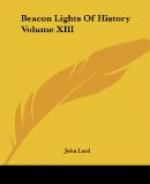Lacking in intensity of passion and dramatic force, Tennyson here again is but typical of his era, to him one of reposeful content and calm, reasoning progress. Of permanent, lasting value much of his verse undoubtedly is, but not all of it will escape the indifference of posterity or the measuring-rod and censure, it may be, of the future critic. He had not the stirring strains or the careless rapture of other and earlier poets of the motherland,—his characteristic is more contemplative and brooding,—yet his range is unusually comprehensive and his power varied and sustained, as well as marked by the highest qualities of rhythmic beauty. In the idyll, where he specially shines, we have much that is lovely and limpid, with abounding instances of that felicitous word-painting for which he was noted. This is especially seen in the simple pastoral idylls, such as ‘Dora,’ ‘The May Queen,’ and ’The Miller’s Daughter,’ or in those tender lyrics such as ‘Mariana,’ ’Sir Galahad,’ ‘The Dying Swan,’ and ‘The Talking Oak.’ In the ballads and songs, how felicitous again is the poet’s work, and how rich yet mellifluous is the strain! Had Tennyson written nothing else but these, with the verse included in the volumes issued by him in 1832 and 1842, how high would he have been placed in the choir of song, and how supreme should we have deemed his art! In “The Princess” alone there are songs that would have made any poet’s reputation, while for music and color, and especially for perfection of poetic workmanship, they are almost matchless in their beauty.
Fortunately, however, the poet was to give us much even beyond these surpassingly beautiful things, and make a more unique and distinctive contribution to the verse of his era. In the years that followed the production of his early writings the poet matures in thought as his art ripens and reaches still higher qualities of craftsmanship. Recluse as he was, he moreover had his experiences of life and drank deeply of sorrow’s cup, as we see in “In Memoriam,”—that noble tribute to his youthful friend, Arthur Hallam, with its grand hymnal qualities and powerful and reverent lessons for an age shifting in its beliefs and unconfirmed in its faith. In later work from his pen we also see the Laureate—for he has now received official recognition from his nation—in his relations to the culture as well as to the thought of his time, keeping pace with the age in all its complex engrossments and problems. This is shown in much and varied work turned out with its author’s loving interest in the poetic art, and with characteristic delicacy and finish. The most important labor of this later time includes “The Princess,” “Maud and Other Poems,” “Enoch Arden,” the dramas “Becket,” “Queen Mary,” and “Harold,” “Tiresias,” “Demeter,” “The Foresters,” but above all, and most notably, that grand epic of King Arthur’s time,—“The Idylls of the King.” In the latter, the most characteristic, and perhaps the most permanent,




